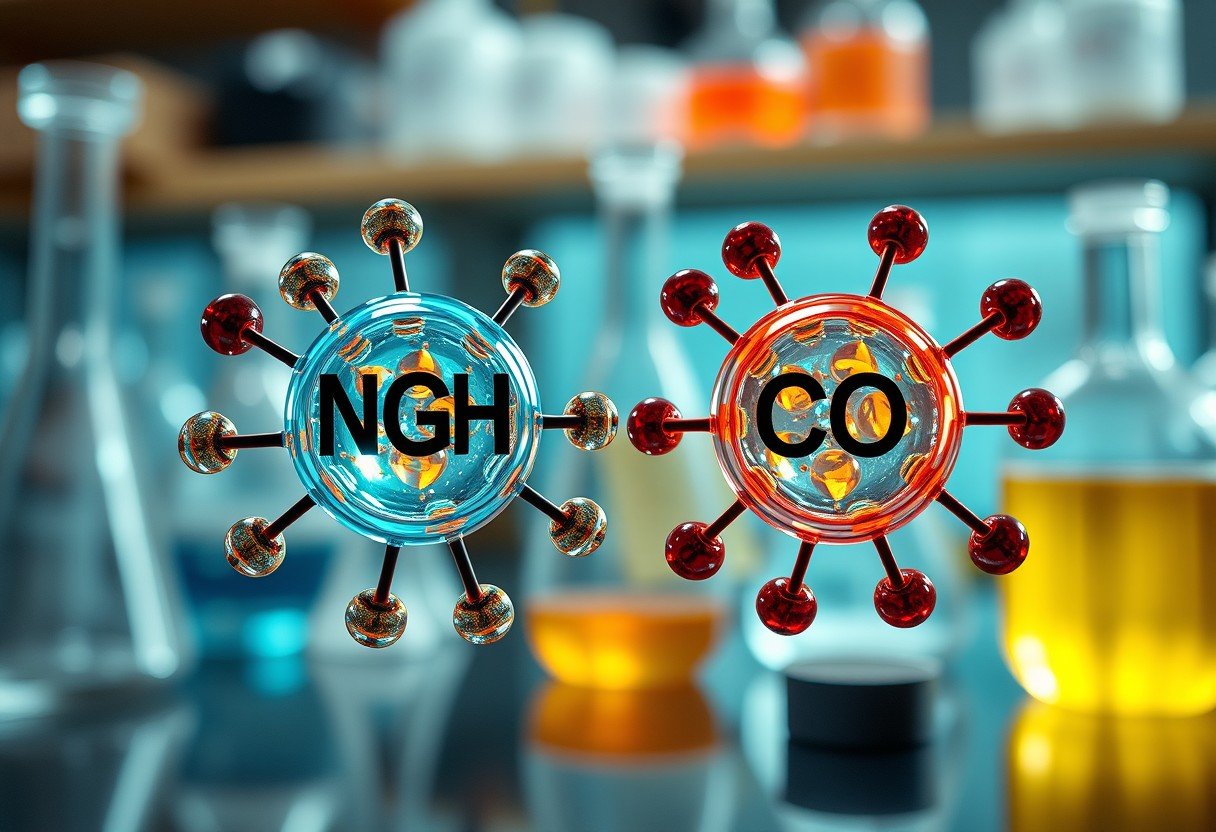Have you ever wondered why you can smell a leaking gas canister from a distance? The answer lies in a process called effusion, where gas molecules escape through a tiny hole. This principle explains why some gases move much faster than others. We will explore how ammonia (NH3) and carbon monoxide (CO) compare, using a key scientific principle to find out exactly how much faster the lighter ammonia molecules travel.
What is Gas Effusion and Why Does it Matter?
Effusion is the movement of gas particles from a container through a very small opening into a vacuum or another space. Imagine air slowly leaking out of a tiny puncture in a tire; that’s effusion in action. This process is different from diffusion, where gases mix together without a barrier.
The speed at which a gas effuses depends on several key factors. Understanding these factors is crucial for many scientific and industrial applications, from separating gases to ensuring safety in chemical plants.
The rate of effusion is primarily determined by the mass of the gas molecules. At the same temperature, lighter molecules move much faster than heavier ones. Think of it like rolling a bowling ball versus a golf ball with the same amount of energy; the golf ball will travel much faster. Other conditions also play a role:
- Temperature: Higher temperatures give gas molecules more kinetic energy, causing them to move and effuse faster.
- Pressure: A higher pressure inside the container will push more molecules out of the opening per second.
- Size of the Opening: The hole must be very small, typically smaller than the average distance the molecules travel before colliding with each other.
Meet the Molecules: Ammonia (NH3) vs. Carbon Monoxide (CO)
To understand their effusion rates, we first need to look at the molecules themselves. Ammonia and carbon monoxide have distinct properties that directly influence how quickly they can move.
The most important difference is their molecular weight, also known as molar mass. Ammonia is made of one nitrogen atom and three hydrogen atoms, making it a relatively light molecule. Carbon monoxide, composed of one carbon and one oxygen atom, is significantly heavier.
This difference in weight is the single biggest reason for their varying speeds. The table below breaks down their key characteristics.
| Property | Ammonia (NH3) | Carbon Monoxide (CO) |
|---|---|---|
| Molar Mass | Approx. 17.03 g/mol | Approx. 28.01 g/mol |
| Molecular Size | Smaller | Larger |
| Composition | 1 Nitrogen, 3 Hydrogen | 1 Carbon, 1 Oxygen |
Understanding Graham’s Law of Effusion
The relationship between a gas’s effusion rate and its mass was described by the Scottish chemist Thomas Graham in the 19th century. His finding, now known as Graham’s Law of Effusion, provides a clear mathematical formula to compare the speeds of two different gases.
Graham’s Law states that the rate of effusion of a gas is inversely proportional to the square root of its molar mass. In simple terms, this means that as the mass of a gas goes up, its rate of effusion goes down, but not in a direct 1-to-1 relationship.
The formula is written as:
Rate of Gas 1 / Rate of Gas 2 = √ (Molar Mass of Gas 2 / Molar Mass of Gas 1)
This powerful equation allows us to predict exactly how much faster a lighter gas will effuse compared to a heavier one, assuming the temperature and pressure are the same for both.
Calculating the Effusion Rate: NH3 vs. CO
Using Graham’s Law, we can now calculate precisely how much faster ammonia effuses than carbon monoxide. It’s a straightforward process that clearly demonstrates the impact of molecular weight.
Here is how you can do it step-by-step:
- Identify the molar masses. As we know, the molar mass of NH3 is about 17.03 g/mol, and the molar mass of CO is about 28.01 g/mol.
- Set up the Graham’s Law equation. We want to find the ratio of the rate of NH3 to the rate of CO. Let’s call NH3 “Gas 1” and CO “Gas 2.”
- Plug the values into the formula. The equation becomes: Rate of NH3 / Rate of CO = √ (28.01 / 17.03).
- Calculate the result. First, divide the molar masses: 28.01 ÷ 17.03 ≈ 1.645. Then, find the square root of that number: √1.645 ≈ 1.28.
The calculation shows that the ratio is approximately 1.28. This means ammonia (NH3) molecules effuse about 1.28 times faster than carbon monoxide (CO) molecules under the same conditions of temperature and pressure.
What Factors Besides Mass Affect Effusion?
While molar mass is the star of the show, other factors like temperature and pressure are critical supporting characters that can change the effusion rate for any gas. It’s important to remember that Graham’s Law works perfectly only when these conditions are held constant for comparison.
Increasing the temperature gives gas molecules more kinetic energy. This makes them move around more rapidly and collide with the walls of the container more often and with more force, increasing the chances of a molecule finding the opening and escaping. Therefore, a hotter gas will effuse faster than a cooler one.
Pressure also plays a direct role. Higher pressure means there are more gas molecules packed into the same space. This higher concentration increases the frequency at which molecules hit the opening, leading to a faster overall rate of effusion. This is why a fully inflated balloon deflates faster than one that is nearly empty.
Real-World Importance of Effusion Rates
This concept isn’t just for chemistry class; it has major implications in the real world. Industries and scientists rely on an understanding of effusion to solve practical problems.
In chemical manufacturing, processes for separating gases often rely on these principles. For example, in uranium enrichment, a method called gaseous diffusion separates heavier uranium isotopes from lighter ones by repeatedly passing a gaseous compound through porous barriers. The lighter isotope effuses slightly faster, allowing it to be gradually separated.
Understanding effusion is also vital for environmental safety. Knowing how quickly a toxic gas can leak and spread helps in designing effective ventilation systems and emergency response protocols. For instance, in the event of an ammonia leak in an industrial facility, its rapid effusion rate means it can disperse quickly, informing how safety zones are established.
Frequently Asked Questions about Gas Effusion
What is Graham’s Law of Effusion in simple terms?
Graham’s Law says that lighter gases travel faster than heavier gases through a small opening. The speed is related to the square root of the gas’s mass, so a gas that is four times lighter will move two times faster.
Why does ammonia effuse faster than carbon monoxide?
Ammonia effuses faster because its molecules are lighter. The molar mass of ammonia (NH3) is about 17 g/mol, while carbon monoxide (CO) has a molar mass of about 28 g/mol. According to Graham’s Law, the lighter substance will always effuse more quickly.
Does the size of the molecule affect effusion?
While molar mass is the primary factor in Graham’s Law, molecular size can play a minor role. However, for the law to be accurate, the opening must be tiny, so the difference in the physical cross-section of molecules is generally considered negligible compared to the effect of mass.
How does temperature change the effusion rate?
Higher temperatures increase the kinetic energy of gas molecules, making them move faster. This increased speed leads to a higher rate of effusion for any gas, as more molecules will find and pass through the opening in a given amount of time.
Where is the principle of effusion used in industry?
This principle is used in several industrial applications, most notably in gas separation and isotope enrichment. It is also fundamental to designing safety systems for handling gases, predicting the dispersal of pollutants, and in various laboratory techniques.









Leave a Comment